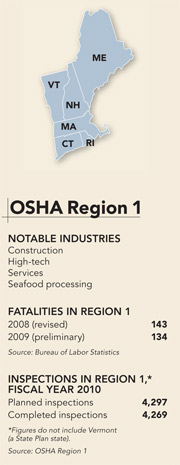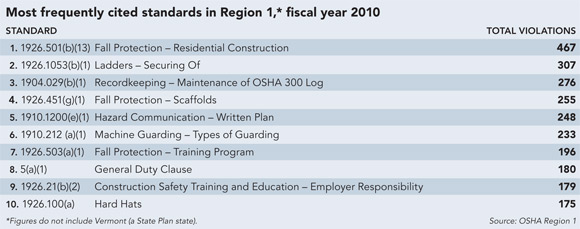Regional Spotlight
Reaching out: OSHA’s Region 1 builds relationships across state, agency lines
By Ashley Johnson, associate editor
About one month before the Deepwater Horizon oil rig exploded in the Gulf of Mexico, OSHA’s Region 1 conducted an emergency response exercise with three states, 16 federal departments and agencies, and 11 companies.
The scenario? An oil spill that stretched from Maine to Virginia.
For Region 1 administrator Marthe Kent, the five-day drill stands out not for its prescience but for the interagency collaboration.
“That exercise demonstrated how important it is – absolutely critical – to work across those lines,” Kent said. “I would say that was a very big exercise for us and something we’re very proud of.”
That type of cooperation is critical to OSHA’s effort to protect workers in Connecticut, Maine, Massachusetts, New Hampshire, Rhode Island and Vermont (a State Plan state).
Reaching out  Despite the economic downturn, construction remains a large part of the region’s economy. OSHA’s major Local Emphasis Programs target residential construction, falls in general industry and construction, and powered industrial trucks. The reason is simple: Of the 60 workplace fatalities OSHA investigated in the region in fiscal year 2010, 12 were fatal falls – nine in residential construction and three involving powered industrial trucks, according to Kent.
Despite the economic downturn, construction remains a large part of the region’s economy. OSHA’s major Local Emphasis Programs target residential construction, falls in general industry and construction, and powered industrial trucks. The reason is simple: Of the 60 workplace fatalities OSHA investigated in the region in fiscal year 2010, 12 were fatal falls – nine in residential construction and three involving powered industrial trucks, according to Kent.
Although Kent does not yet have data to measure the LEP’s success, she pointed to another indicator. “I can tell you, particularly in residential construction, we’ve made the hit parade,” she said. “You see articles, and people are talking about it, and the people involved are coming to us and asking for help. So they’re coming to our compliance assistance specialists and asking for help. I would say that’s particularly true in Massachusetts and Connecticut.”
A major challenge for the region is reaching immigrant and non-English-speaking workers and employers in various industries. Last year, Region 1 started its own version of “OSHA Listens” aimed at these workers. The agency partners with unions, councils on occupational safety and health, community groups, and faith-based organizations to set up evening meetings with workers – a time when most of them are available.
The meetings, which Kent called “phenomenally good,” also have helped officials identify new hazards, such as workers in recycling plants not having adequate personal protective equipment.
Safety in the seafood processing industry also emerged as a concern in the region. Kent described a worker whose hands and arms were covered in sores because he did not have PPE to wear while cutting open dogfish at a plant in New Bedford, MA. Seeing his wounds caused Kent to increase attention on seafood plants.
SHARP focus
Along with reaching out to immigrants and non-English-speaking workers and employers, Region 1 works hard to establish relationships with small businesses, Kent said. When she arrived at the agency in 2003, the region had eight employers in OSHA’s Safety and Health Achievement Recognition Program, which recognizes exemplary small employers. Now, Region 1 has 72 SHARP sites.
Region 1 also hosts monthly roundtables in Massachusetts, New Hampshire and Rhode Island, during which employers can share lessons learned and talk to compliance assistance specialists without fear of enforcement. “It’s an environment where they can talk very freely,” Kent said.
Cross-referrals are a key part of the region’s success. For example, Kent said OSHA has an initiative with building inspectors that allows them to alert each other about problems. “Even though it’s not in our ‘jurisdiction,’ there’s a lot of cross-talk,” she said. “It works both ways. I make referrals to them; they make referrals to us.”
The emphasis on working across lines has paid off, especially in Vermont, which runs its own OSHA program. Kent said Vermont did not have a whistleblower program or debt collection eight years ago. Region 1 worked with then-Gov. Jim Douglas (R) and labor commissioners to improve the state’s program, and the agencies now have a close working relationship, she said.

Stopping ‘gas blows’
Region 1 saw its share of significant workplace incidents in 2010, including a patient shooting a nurse at a Connecticut hospital and an employee killing himself and eight co-workers at a family-owned beer distributor in Manchester, CT.
An incident that captured national attention was a natural gas explosion at the Kleen Energy Systems LLC plant in Middletown, CT, that killed six workers. The February blast occurred during a gas blow, a procedure that involves pumping flammable natural gas through pipes at a high speed to clear out debris.
Region 1 devoted seven full-time-equivalent employees to the case for six months. “And I mean full time,” Kent stressed. “They were living in trailers. They were not with their families. They would come home on Sunday if they were lucky.”
The investigation led to $16.6 million in proposed penalties against three construction companies and 14 site contractors.
Preventing gas blows across New England remains a priority for Region 1. Connecticut Gov. M. Jodi Rell (R) issued an executive order banning the practice in the state. Kent said the office has stopped at least two or three gas blows since the explosion.
In fact, she said, while still investigating the Kleen explosion, OSHA learned about a scheduled gas blow and promptly sent an inspector to the site. The inspector reviewed the process, and the employer changed his mind and decided to use a safer alternative.
Post a comment to this article
Safety+Health welcomes comments that promote respectful dialogue. Please stay on topic. Comments that contain personal attacks, profanity or abusive language – or those aggressively promoting products or services – will be removed. We reserve the right to determine which comments violate our comment policy. (Anonymous comments are welcome; merely skip the “name” field in the comment box. An email address is required but will not be included with your comment.)

